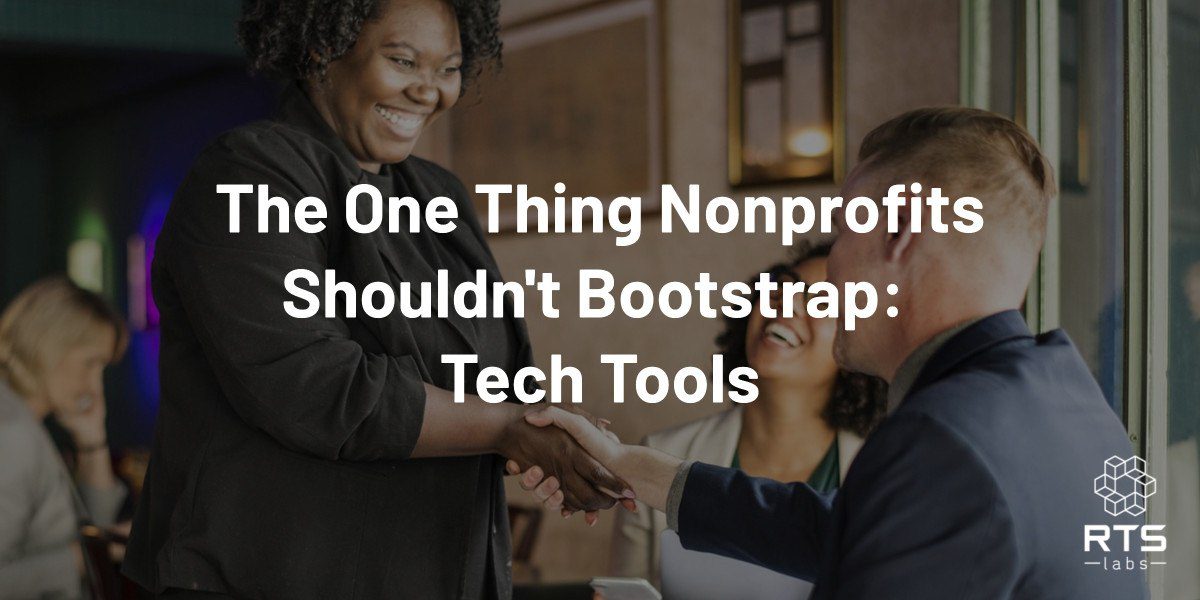Most nonprofits have the same thing in common: There’s a lot of work to be done but not enough resources to tackle it all. To be effective at accomplishing your mission as a nonprofit, you need to be lean. And being lean often means bootstrapping solutions to get all the work done.
While you may have a clear vision about engaging donors and the purpose of your work, is there anything in your mission statement that talks about administration? If you’re like many nonprofits, probably not. Because at the end of the day, the admin work is not what gets you out of bed in the morning; it’s just a necessary evil.
What if you could get more done without hiring extra hands? How much more could you accomplish – and how much money could you save that could then direct toward your mission?
That’s where technology comes in. There’s a time to bootstrap and there’s a time to be smart and invest in your future. Knowing the difference can be hard. These four administrative tasks are important enough that your nonprofit should use technology to get them done better and faster instead of bootstrapping them. Because when it comes to technology and automation, the investment will pay off in more ways than one.
Reporting
You could spend your time (or pay someone else to spend their time) pouring over the numbers, jumping back and forth between spreadsheets, and formatting reports for your board, donors, sponsors, and staff. But why do that when you can automate your reporting functions with business intelligence?
Business intelligence (BI) tools allow you to pull various data sources into one dashboard where everything is at your fingertips. Reports can be pulled with the click of a mouse, visualizations can be created in minutes, and your reporting can be automated. BI allows for rapid analysis of data, so the big picture is easier to see and decisions can be made quickly.
Storytelling
Telling stories is an important part of communications for any organization – but for nonprofits it is absolutely crucial. Tugging at heartstrings and showing impact is more than just prose. Telling a good story is just as much about numbers and visualizations as it is about words.
That’s where data comes in. Data is your proof. It shows the magnitude of the work you’ve been doing. And when that data can be visualized with the click of a button? Now you’re talking conversions and donations.
Nonprofits that have a handle on their data are much better at telling stories. When all of your data is organized using a tool such as Tableau, the process becomes easier. Your marketing team can log in, pull the stats they need, create stunning visuals, and add compelling impact stories to newsletters, blogs, social media posts, or even donor letters. Data adds power to prose. And powerful stories equal more donations.
Donor engagement
Donors = dollars, which is why keeping them engaged and happy is crucial. Technology can make that process so much easier and help keep important sales tasks in the donor lifecycle from falling through the cracks. That’s where a good client relationship management (CRM) system comes in handy. Donors don’t want to feel like a number. They want to feel appreciated. Likewise, you want to make sure to follow up regularly with potential and previous donors and glean sales data from your donors’ habits.
Good CRM software is designed in a very deliberate way that helps you track your supporters’ habits while helping you keep track of where they are in the donor lifecycle. Good tracking can actually help you build relationships and get to know your supporters better, because you can set alarms for follow-up activities and keep notes about the things that are important to them (i.e., Ms. Jones likes to be called in the evenings; Mr. Brown likes to be called by his first name “Isaiah;” the Rays like to hear about programs for children; etc.)
And then there’s the data you can track in CRM. You can track donor preferences and trends. For example, what is the average donation of each donor or which form of communication do they prefer or respond to the most? CRM can help you see and manage each relationship by providing you with data for how often you’re reaching out, the last interaction you had, and each person’s contribution history. This will help ensure you are not leaving money on the table. For example, are you asking everyone for $20 when some of your donors are used to giving $100? The more you know about your donors, the better you will get at keeping those much needed donations coming in.
What’s great about CRM is that it can be hooked up to your email marketing software so your emails can be automated yet personalized.
Website
Your website is one of the biggest marketing tools you have. It’s crucial that the design, functionality, and text are flawless so visitors can easily identify what you do, the impact it has, and how they can help. Is information easy to find? Are you telling the right stories? Can people make donations and order items right from your website? Can they sign up for email updates or mailings?
Beyond creating a great user experience, you also need to make sure updating your website is easy for your staff. It shouldn’t take hours to make simple changes.
That’s why investing in your website and making sure it works flawlessly is worth it. After all, your website is your stand-in salesperson when you can’t meet with someone in person. Make sure it’s as engaging as you would be if you were standing before a new prospect and that it answers the questions people have about you and your organization.
To spend or not to spend
There’s a time to bootstrap and a time to be smart and invest in technology that will ultimately help you run leaner, maximizing your efficiency and stretching your budget further. Knowing the difference can be hard. Best to automate the admin work so you can spend more time and money on your mission.
Learn how we used technology to help this nonprofit increase membership and revenue – by simply tapping into the data they didn’t even know they had.






